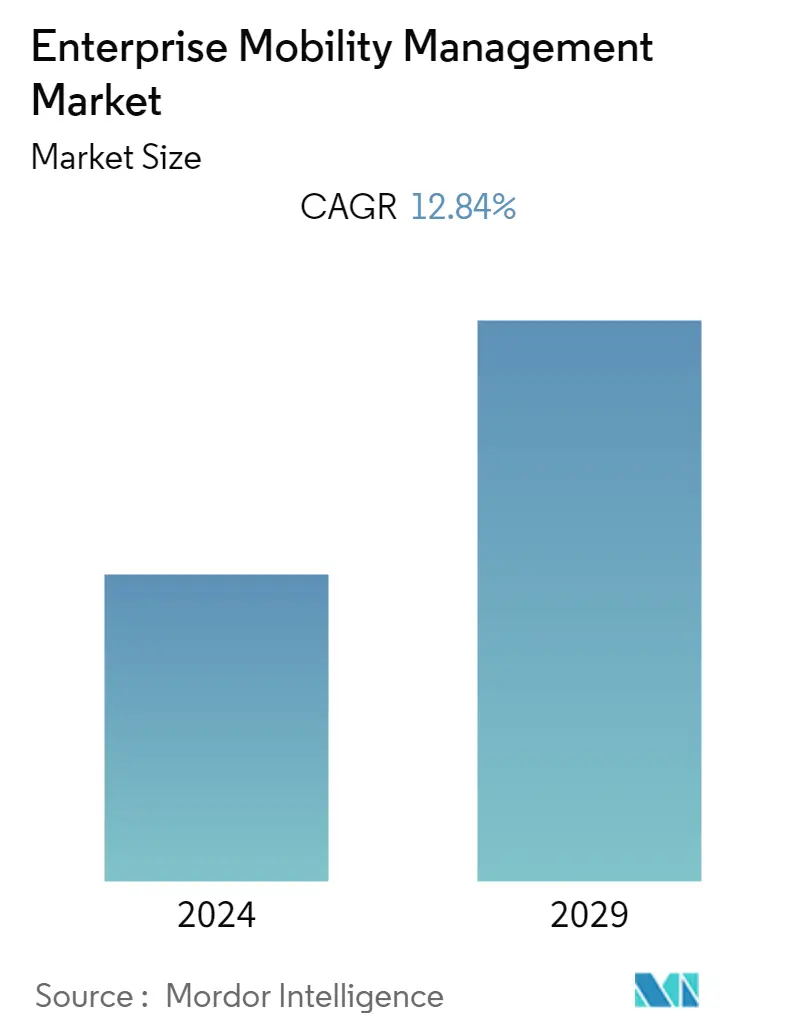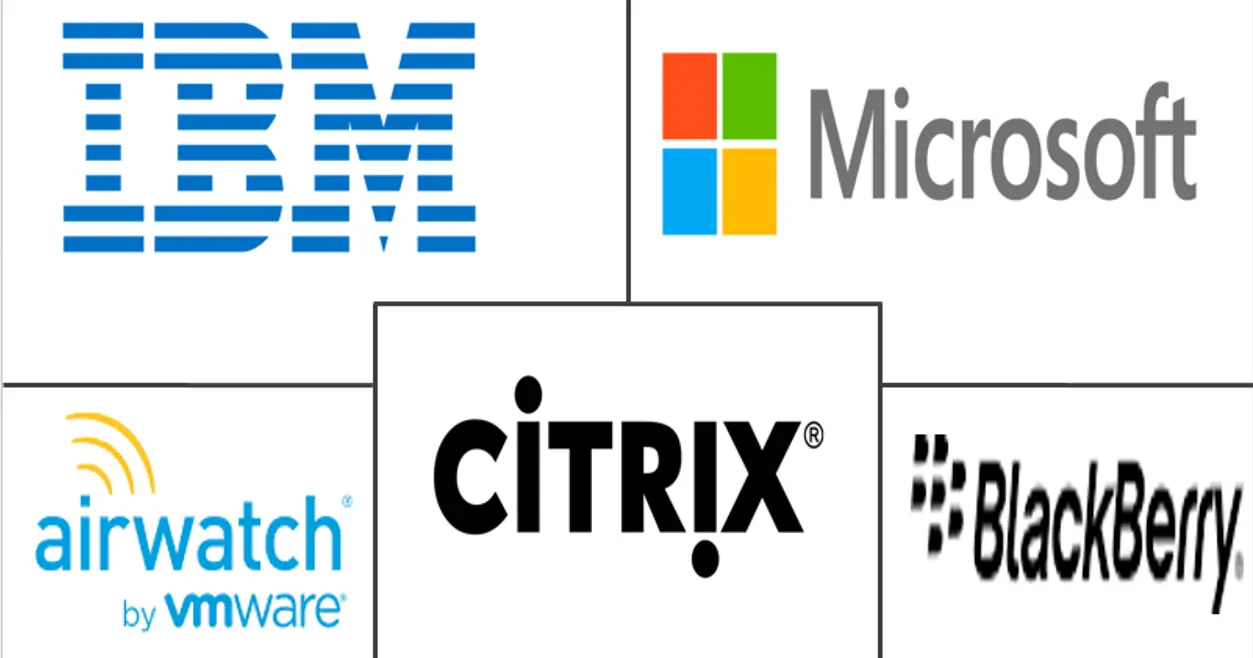Market Size of Enterprise Mobility Management Industry

| Study Period | 2019 - 2029 |
| Base Year For Estimation | 2023 |
| CAGR | 12.84 % |
| Fastest Growing Market | Asia Pacific |
| Largest Market | North America |
| Market Concentration | Medium |
Major Players
*Disclaimer: Major Players sorted in no particular order |
Enterprise Mobility Management Market Analysis
The Enterprise Mobility Management market is registering a CAGR of 12.84% over the forecast period. A comprehensive EMM solution comprises features required for mobile deployments, such as application and content-level control, on a single unified platform. Due to more organizations adopting flexible policies, they are turning toward EMM to supersede the pitfalls of allowing personal devices to access corporate data.
- Enterprise mobility management (EMM) solutions are gaining prominence owing to some of the major enterprise trends, such as bring-your-own-device (BYOD) and choose your device (CYOD) policies, in which companies are allowing employees to use external or internal devices for enterprise-related work. Thus, deploying appropriate controls in companies is expected to benefit them from mobility opportunities while ensuring that sensitive data and devices are safeguarded.
- The growing application of ERP software and CRM systems has increased the use of mobility solutions in the market. ERP is usually a category of business-management software, typically a suite of integrated applications that an organization may use to collect, store, manage, and interpret data from various business activities. According to Computer Weekly, enterprise resource planning (ERP) and customer relationship management (CRM) remain the most vital categories for business applications.
- EMM practices usually incorporate mobile management systems or services to offer intellectual property protections and a security-rich environment for data management. End users, like retailers, require EMM as the employees use smartphones as point-of-sale (POS) devices to scan bar codes, conduct payments, and process transactions. At the same time, banks and allies are pivoting to allow BYOD and require EMM for secure data and regulatory compliance for their financial exchanges.
- The smartphones and related devices used by employees must be able to process data and files in accordance with the workload's requirements in addition to running enterprise apps. Integrating endpoint devices with all organizational systems and achieving seamless synchronization between them is a big challenge for the organization's IT team and is restricting the market growth.
- With the outbreak of COVID-19, most organizations have shifted to the work from the home model due to the lockdown ad social distancing measures that have created a significant demand for managing the application and devices while monitoring the application aspect remotely. Therefore, several companies offering application and device management services are updating and providing a suite of services with the increased demand from the organization for managing their mobile device needs.
Enterprise Mobility Management Industry Segmentation
Enterprise mobility management (EMM) addresses the need for managing the devices while providing greater agility brought on by a shift from the traditional central office business model among the enterprise to mobile equipment and computing solutions. EMM software also helps employees be more productive because IT departments can provide them with the applications and data they need to perform work-related tasks on mobile devices.
The Enterprise Mobility Management Market is segmented by Type (Solutions, Services), End User (BFSI, Healthcare, IT and Telecom, Manufacturing, And Retail), and Geography.
| Type | ||||||
| ||||||
| Services |
| End User | |
| BFSI | |
| Healthcare | |
| IT and Telecom | |
| Manufacturing | |
| Retail | |
| Other End Users |
| Geography | |
| North America | |
| Europe | |
| Asia Pacific | |
| Latin America | |
| Middle East and Africa |
Enterprise Mobility Management Market Size Summary
The Enterprise Mobility Management (EMM) market is experiencing significant growth, driven by the increasing adoption of flexible work policies such as bring-your-own-device (BYOD) and choose-your-own-device (CYOD) strategies. These trends are prompting organizations to implement EMM solutions to manage mobile deployments effectively, ensuring the security of corporate data accessed through personal or external devices. The integration of EMM with enterprise resource planning (ERP) and customer relationship management (CRM) systems is further propelling market expansion, as these systems require robust mobility solutions for data management and security. The COVID-19 pandemic has accelerated the demand for EMM, as remote work necessitates comprehensive application and device management to maintain operational continuity and data security.
North America is poised to maintain a dominant position in the EMM market, fueled by the region's strong focus on digital transformation and the presence of major technology vendors. The United States, in particular, is witnessing high demand for EMM solutions across various sectors, including banking, retail, manufacturing, and healthcare, due to the need for enhanced data security and regulatory compliance. Companies like VMware and Google are continuously innovating to meet the evolving needs of enterprise customers, offering solutions that integrate access control, application management, and endpoint management. The competitive landscape of the EMM market is characterized by significant investments in research and development, strategic collaborations, and acquisitions, as companies strive to enhance their service offerings and maintain a competitive edge.
Enterprise Mobility Management Market Size - Table of Contents
-
1. MARKET DYNAMICS
-
1.1 Market Overview
-
1.2 Industry Attractiveness - Porter's Five Forces Analysis
-
1.2.1 Bargaining Power of Suppliers
-
1.2.2 Bargaining Power of Consumers
-
1.2.3 Threat of New Entrants
-
1.2.4 Threat of Substitutes
-
1.2.5 Intensity of Competitive Rivalry
-
-
1.3 Assessment of the Impact of COVID-19 on the Industry
-
1.4 Market Drivers
-
1.4.1 Growth of Mobile Devices as the Preferred Medium of Accessing Internet, Enterprise Data, and Various Other Information
-
1.4.2 Rising BYOD Trend across End-user Industries
-
-
1.5 Market Restraints
-
1.5.1 Cost Associated with EMM Deployment Upgradation Complexities
-
-
-
2. MARKET SEGMENTATION
-
2.1 Type
-
2.1.1 Solutions
-
2.1.1.1 Device Management
-
2.1.1.2 Security Management
-
2.1.1.3 Application Management
-
2.1.1.4 Other Solutions
-
-
2.1.2 Services
-
-
2.2 End User
-
2.2.1 BFSI
-
2.2.2 Healthcare
-
2.2.3 IT and Telecom
-
2.2.4 Manufacturing
-
2.2.5 Retail
-
2.2.6 Other End Users
-
-
2.3 Geography
-
2.3.1 North America
-
2.3.2 Europe
-
2.3.3 Asia Pacific
-
2.3.4 Latin America
-
2.3.5 Middle East and Africa
-
-
Enterprise Mobility Management Market Size FAQs
What is the current Enterprise Mobility Management Market size?
The Enterprise Mobility Management Market is projected to register a CAGR of 12.84% during the forecast period (2024-2029)
Who are the key players in Enterprise Mobility Management Market?
Citrix Systems, Inc., IBM Corporation, Microsoft Corporation, BlackBerry Limited and AirWatch (Vmware Inc.) are the major companies operating in the Enterprise Mobility Management Market.

